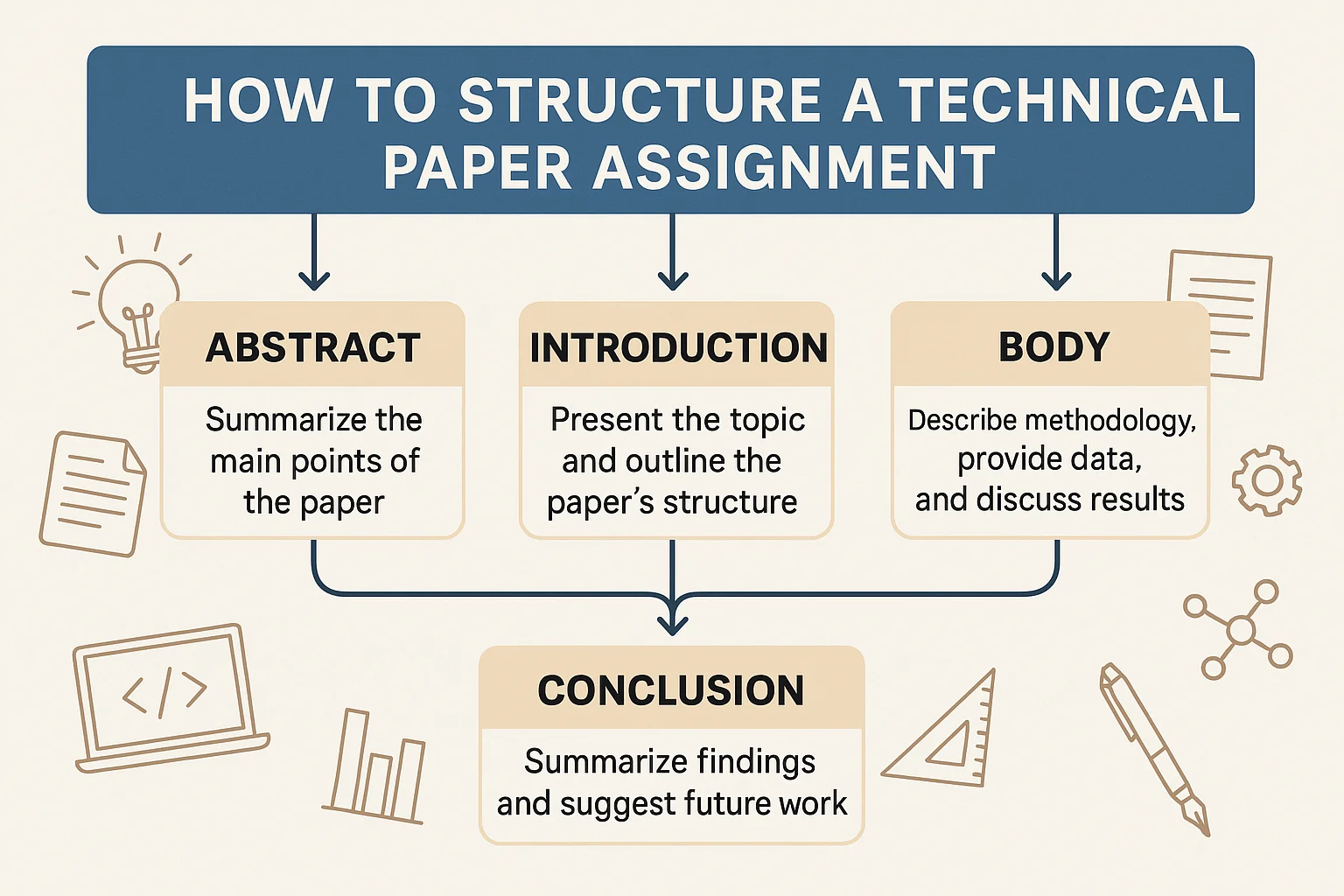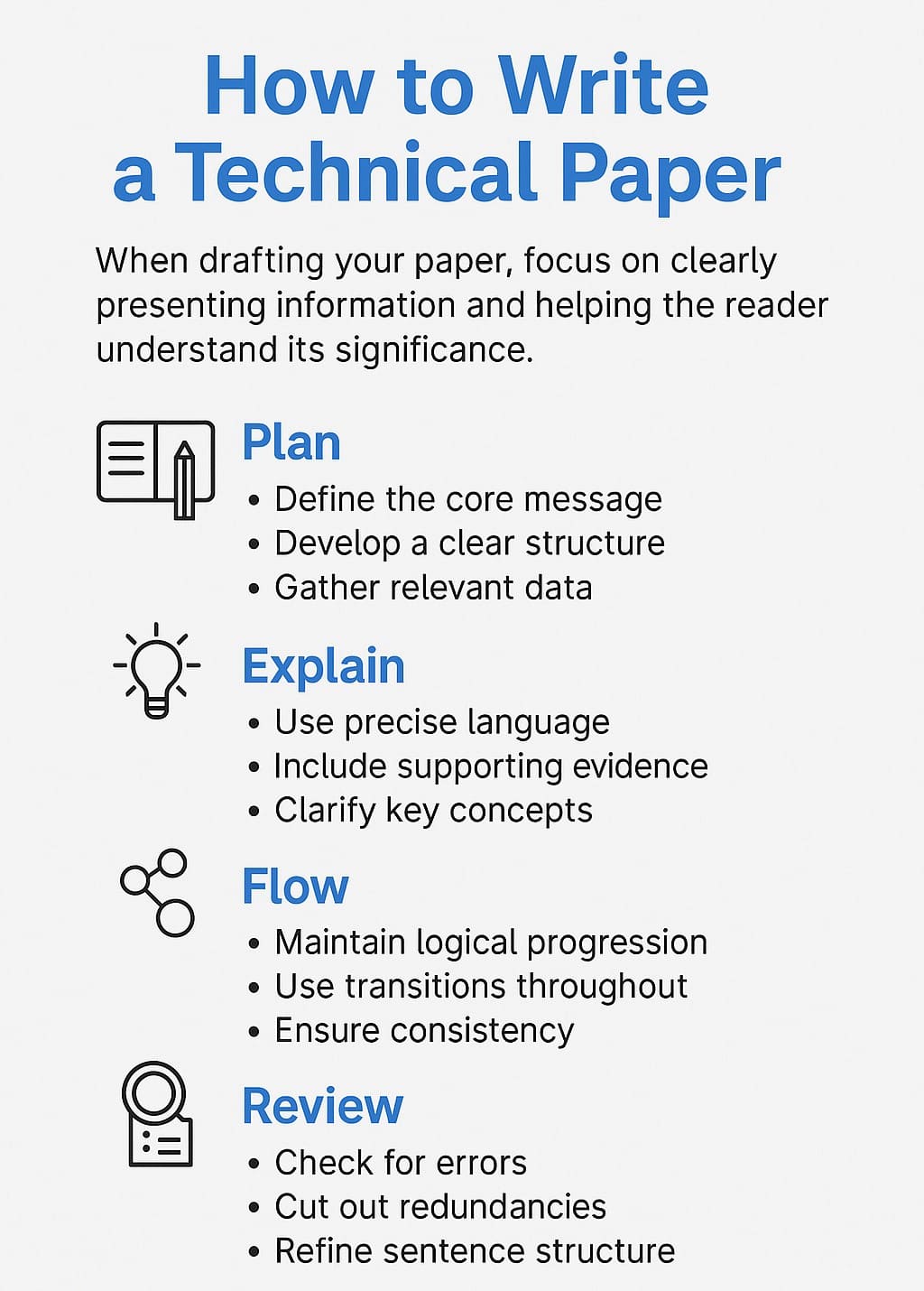- Blog
- Mastering How to Write a Technical Paper Effortlessly
Mastering How to Write a Technical Paper Effortlessly
 Mary Watson
Mary Watson

Wondering how to write a technical paper? To accomplish this, you need to explain complex information clearly and concisely, often focusing on research findings, methodologies, or innovations. For technical papers to communicate ideas effectively they need to combine thorough research with careful organization alongside precise language. The procedure requires researchers to present data and analyze results before drawing logical conclusions. Effective technical writing delivers information while enabling readers to grasp its significance and consequences.
Understanding the Basics of a Technical Paper
A technical paper is a structured document that contains comprehensive details and analysis about a particular subject. The design of technical papers enables them to present complex subjects through informative explanations or evaluations that readers can easily comprehend. Scientific methods, technical processes, and experimental results frequently appear in these papers, which means clarity and organization become critical components when following a typical technical paper format.
Laying the Groundwork for a Strong Paper
Success starts before writing begins. Thorough preparation helps you save time and creates a seamless flow of ideas. The foundation of an effective paper emerges from creating a clear plan, defining the main objective, and collecting relevant information.
Picking the Perfect Technical Paper Topic
Selecting the appropriate subject guides the overall course of technical paper development. Choose topics that provide ample substance for examination yet maintain relevance with today's trends. The following list presents 10 trending ideas that establish a strong foundation for research:
- Artificial Intelligence in Healthcare
- Blockchain Technology and Data Security
- Sustainable Energy Solutions for Urban Areas
- Ethical Implications of Autonomous Vehicles
- Internet of Things (IoT) in Smart Cities
- Quantum Computing and Its Future Potential
- Advances in Biotechnology and Genetic Engineering
- Cybersecurity Threats and Modern Defense Strategies
- Cloud Computing for Business Efficiency
- Augmented Reality Applications in Education
Adapting Your Paper to Suit Your Audience
The intended audience of the paper guides both its content and tone. Accessible information dissemination requires adjusting both language and complexity to suit industry professionals, academics, as well as general readers. Whenever complex ideas arise in your writing, break them down for easier understanding while keeping an objective tone to earn your audience's trust.
Defining the Main Point with Clarity
Determining the central message helps a technical paper maintain focus. All sections must follow the central idea to remain relevant to the main topic. Maintaining a single main goal helps avoid irrelevant deviations and ensures a straightforward technical paper structure. The message becomes clearer to readers when supporting evidence and examples back it up.
Struggling with a technical essay? We’ve got you covered! Our essay writing help service is here to guide you through structuring, formatting, and perfecting your paper. Whether it’s for school or college, we’re ready to assist with expert support. Don’t stress – reach out today!
Gathering Information and Putting It in Order
The foundation of a strong technical paper rests in an effective research organization. Start your research work by identifying dependable resources that deliver up-to-date and accurate data. Note-taking while reviewing materials helps avoid overlooking crucial details. Grouping similar ideas together helps to identify conceptual relationships more easily when writing a thesis for a technical paper. Creating a primary framework following information organization protects structural integrity and keeps content focused.
Crafting a Solid Technical Paper Structure
A clear structure provides the backbone of a technical paper. Start with a strong technical paper introduction that establishes the topic and defines the paper's objectives. Within the body section, the main ideas need to be presented in a logical order, and each point should be backed up with evidence. Sections must flow seamlessly into each other to ensure the document continues without interruption. Conclude the paper by summarizing the research findings and reiterating the main objective.

Read also: How to Write All Kinds of Essays
Mastering Clarity in Your Writing
Good technical writing balances detail with simplicity. The clarity of the language maintains accessibility to complex ideas. The use of plain language and a clear tone keeps readers interested because it reduces barriers to understanding. Audiences can concentrate on the information when precise wording removes confusion and eliminates complicated phrasing.
Choosing Technical Paper Words That Keep It Clear
Technical writing requires straightforward and uncomplicated language to be effective. Technical documents require clear language by defining complex vocabulary to prevent misunderstandings while eliminating extra words to sustain clarity. Accurate communication of ideas depends on the use of precise vocabulary. Eliminate ambiguous expressions which might cause confusion and strive to communicate your ideas as directly as possible.
Balancing Active and Passive Voice
The use of both active and passive voice in technical writing benefits from a strategic application that enhances readability. Active voice produces direct and interesting sentences, but the passive voice should be used when you want to emphasize the action instead of the subject. The table below highlights examples of both:
| Active Voice | Passive Voice |
|---|---|
| The researcher analyzed the data | The data was analyzed by the researcher |
| We developed the software | The software was developed by us |
| The system processes the requests | The requests are processed by the system |
Ensuring a Smooth and Logical Flow
The proper organization of a technical paper ensures that ideas flow sequentially for the reader. Authors should design sections to develop from earlier content which will lead to a coherent sequence of thoughts. Transitional phrases maintain coherence while making sure ideas connect seamlessly. The uniformity of tone and structure proves essential for maintaining an easy-to-follow narrative.
Avoiding Errors That Weaken Your Paper
Minor errors detract from the core meaning of the content. Reviewing grammar, spelling, and punctuation is essential to keeping the paper's tone professional. Correct any inconsistencies in formatting terminology or citation style to preserve uniformity across your work. Monitoring repetition and redundancy helps maintain a clean and streamlined text.
Ways to Make Your Paper Stand Out
Capturing and holding the reader’s attention makes a technical paper more effective. Incorporating relevant examples, clear explanations, and engaging visuals keeps the content interesting. You can also use various technical paper techniques in writing to spice up your paper. Below are a few simple strategies to add depth and variety:
- Add real-world applications to illustrate key points.
- Break down complex ideas into simpler sections for better understanding.
- Use charts, graphs, or diagrams to visualize data.
- Include quotes or insights from experts to strengthen arguments.
- Create smooth transitions to maintain the flow between sections.
Read more: How to Write a Good Essay
Perfecting Your Paper Through Careful Edits
Polishing a technical paper ensures that ideas are presented clearly and logically. Careful review improves grammar, consistency, and overall structure. Below are a few essential steps for effective editing and revision:
- Check for grammatical errors and punctuation mistakes.
- Eliminate unnecessary words to keep sentences concise.
- Ensure each section follows a logical sequence.
- Verify that data, references, and citations are accurate.
- Read aloud to catch awkward phrasing and refine sentence structure.

Practical Example of a Well-Structured Technical Paper
Want to see all our tips in action? Look through the technical paper example below.
Analyzing the Impact of Artificial Intelligence on Healthcare Efficiency
Abstract
Artificial Intelligence (AI) has emerged as a powerful tool in the healthcare industry, transforming patient care, diagnosis, and administrative processes. This paper explores how AI technologies improve efficiency by reducing errors, speeding up diagnoses, and enhancing data management. The research highlights both the potential benefits and the challenges of integrating AI into healthcare systems.
Introduction
AI is reshaping the healthcare landscape by introducing innovative ways to handle medical data and automate repetitive tasks. As technology advances, machine learning algorithms and natural language processing (NLP) tools are becoming more accurate and efficient. The focus of this paper is to assess how AI enhances operational efficiency, improves patient outcomes, and reduces the workload on healthcare professionals.
AI in Medical Diagnosis
One of AI's most notable applications is its ability to assist in diagnosing diseases. Algorithms trained on large datasets can analyze medical images, lab results, and patient histories to identify patterns that might go unnoticed by human practitioners. For instance, AI systems like IBM Watson assist oncologists in identifying cancer stages with remarkable precision. These tools not only increase diagnostic accuracy but also reduce the time taken to arrive at a diagnosis.
Enhancing Patient Care Through Predictive Analytics
Predictive analytics, powered by AI, enables early detection of potential health risks. By analyzing vast amounts of patient data, these models identify trends and warn healthcare providers about possible complications. Early intervention based on such insights improves patient outcomes and minimizes the need for extensive treatments. Hospitals have started leveraging AI-driven systems to predict patient deterioration, allowing timely medical responses.
Streamlining Administrative Tasks
AI also boosts efficiency by automating routine administrative tasks. Scheduling appointments, processing insurance claims, and maintaining medical records consume significant time for healthcare staff. AI systems handle these processes quickly and with fewer errors, allowing professionals to focus more on patient care. Chatbots and virtual assistants provide immediate responses to patient inquiries, improving service quality.
Challenges and Ethical Considerations
While AI offers numerous benefits, integrating these systems into healthcare poses challenges. Continuous oversight is required to ensure data privacy, minimize biases in AI models, and maintain transparency in decision-making. Additionally, training healthcare professionals to use AI tools effectively remains essential for maximizing potential benefits while minimizing risks.
Conclusion
AI holds great promise for enhancing efficiency in healthcare by improving diagnosis, predicting health risks, and automating administrative tasks. However, successful integration requires addressing ethical concerns and ensuring ongoing evaluation of AI systems. As technology evolves, striking a balance between innovation and responsible implementation will be key to reaping the full benefits of AI in healthcare.
Analysis
This example highlights the importance of maintaining a logical structure when writing a technical paper. The introduction clearly defines the purpose, while the body presents relevant information in distinct sections. Each part builds on the previous one, ensuring a smooth progression of ideas. The technical paper conclusion summarizes key findings without introducing new information. Following a similar approach helps create an engaging and well-organized technical paper.
Read more: A Guide on How to Write a Great Analytical Essay
Personal Reflections and Expert Tips for Technical Paper Success
Over the years, writing technical papers has taught me valuable lessons. Early attempts often struggled with structure and clarity. Back then, focusing too much on intricate details without a clear technical paper outline led to confusion. After realizing that a well-defined structure creates a smooth reading experience, papers became easier to manage. Each section now serves a specific purpose, guiding readers logically through the content.
One experience that stood out involved working on a technical paper about AI applications in education. Initially, the focus was too broad, which made it difficult to maintain a coherent narrative. Narrowing the topic and defining a clear objective helped sharpen the paper's focus. Breaking down complex ideas into smaller, digestible sections also made a huge difference.
Another important lesson involved maintaining a balance between detail and simplicity. There are numerous ways to write a technical paper, but you should always avoid diving deep into jargon. Simplifying concepts for a wider audience has proven to be more effective. It’s not about dumbing down the content but ensuring that readers grasp the core ideas without unnecessary complexity.
Polishing a technical paper takes patience. The importance of revisiting drafts and refining sections cannot be overstated. After completing several papers, one strategy that worked consistently was reading the text aloud to catch awkward phrasing and ensure a natural flow, which is why I always mention it when sharing tips for writing a technical essay. This simple technique revealed errors that might have gone unnoticed otherwise.
In the end, each technical paper reflects the effort, research, and care put into it. Sharing these insights adds value for others navigating the same process.
Drowning in assignments and don’t know where to start? Just say, “Do my homework online,” and let our expert writers take over. From technical essays to research papers, we’ll handle the hard part while you focus on what matters. Sit back, relax, and watch your grades soar!
FAQ
How long should a well-structured technical paper be?
Technical papers lack a standardized length yet typically contain 5 to 15 pages which varies according to the topic and complexity level. While shorter papers concentrate on particular concepts they address, longer papers deliver comprehensive analyses of their subjects.
What is the best way to present a technical paper?
Technical papers require a logical structure consisting of three parts: an introduction, a body, and a conclusion. The introduction establishes the background information and prepares readers for the ensuing discussion. Technical paper body paragraphs systematically display the research findings alongside analytical insights and significant discoveries. The final section wraps up the discussion by reviewing the key points and reaffirming the central message.
How to write a good technical paper introduction section?
An opening with either a thought-provoking question, a surprising fact, or a brief anecdote generates immediate reader interest. In cybersecurity writing, engaging readers is possible by starting with a data breach scenario that reveals confidential information. An engaging opening statement establishes the atmosphere and motivates readers to continue exploring the material. Example:
Imagine a world where sensitive data is compromised with a single click. Unfortunately, this is not a hypothetical scenario. Cybersecurity threats continue to evolve, making it essential to stay ahead of potential risks. This paper explores modern defense strategies designed to safeguard digital environments.
How to write a technical essay conclusion?
Effective conclusions strengthen the primary message while avoiding new information. Highlighting essential findings and demonstrating their importance creates a memorable impact. The conclusion should guide readers to consider the next steps or future outcomes to deepen their understanding of the material. Example:
The integration of artificial intelligence in healthcare has demonstrated promising results in improving diagnosis, streamlining administrative tasks, and enhancing patient care. However, as technology continues to evolve, maintaining ethical standards and addressing privacy concerns will be crucial for ensuring lasting benefits.

Mary, our exceptional editor and online tutor, brings a wealth of knowledge to the table. With her extensive expertise in academic writing, she guides and mentors aspiring students, providing them with constructive feedback that propels their essays to the next level.


 Mary Watson
Mary Watson

